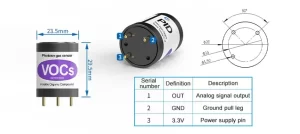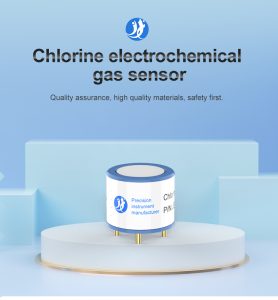Air pollution poses a significant threat to human health and the environment. As cities grow and industrial activities expand, monitoring air quality becomes crucial for understanding pollution sources, assessing their impact, and implementing effective mitigation measures. Gas sensors have emerged as powerful tools in advancing air quality monitoring. This article explores the significance of gas sensors, their applications, advancements, and future prospects in enhancing air quality management.

Understanding Gas Sensors:
Gas sensors are devices designed to detect and quantify different gases present in the atmosphere. They utilize various technologies such as electrochemical, optical, and semiconductor-based methods to measure gas concentrations accurately. Gas sensors can detect a wide range of pollutants, including carbon monoxide (CO), nitrogen dioxide (NO2), ozone (O3), sulfur dioxide (SO2), volatile organic compounds (VOCs), and particulate matter (PM).
Applications of Gas Sensors in Air Quality Monitoring:
Gas sensors play a vital role in monitoring air quality and provide valuable data for various applications:
2.1 Urban Air Quality Monitoring:
Gas sensors are deployed in urban areas to monitor pollutant levels and assess air quality conditions. They help identify pollution hotspots, track variations over time, and determine the effectiveness of pollution control measures. Data from gas sensors enable policymakers to make informed decisions and develop targeted strategies to improve air quality in urban environments.
2.2 Industrial Emissions Monitoring:
Gas sensors are used in industries to measure pollutant emissions and ensure compliance with environmental regulations. By monitoring gas concentrations at emission sources, industries can identify potential leaks or malfunctions and take corrective actions promptly. Gas sensors contribute to reducing emissions, minimizing environmental impact, and ensuring a safer working environment for employees.
2.3 Indoor Air Quality Monitoring:
Gas sensors are employed to monitor indoor environments such as homes, offices, and schools. They detect pollutants originating from indoor sources like cooking, cleaning products, and building materials. Monitoring indoor air quality helps ensure a healthy and comfortable living or working environment, reducing the risk of respiratory issues and improving overall well-being.
2.4 Personal Exposure Monitoring:
Gas sensors can be integrated into wearable devices to monitor individual exposure to pollutants. This provides real-time data on personal exposure levels and allows individuals to make informed decisions about their activities and protect themselves from hazardous environments. Personal exposure monitoring enhances public awareness of air pollution and empowers individuals to take proactive measures for their well-being.
Advancements in Gas Sensor Technology: Advancements in gas sensor technology have significantly enhanced their performance and capabilities:
3.1 Miniaturization and Portability: Gas sensors have become smaller, more compact, and portable, enabling widespread deployment and mobility. Miniaturized gas sensors can be integrated into mobile devices, wearable technologies, and drones, expanding the scope of air quality monitoring and enabling data collection in previously inaccessible areas.
3.2 Selectivity and Sensitivity:
Modern gas sensors exhibit higher selectivity and sensitivity, allowing for the detection and differentiation of specific gases even at low concentrations. This enables the identification of pollutant sources, tracing the origin of emissions, and assessing the effectiveness of pollution control measures with greater precision.
3.3 Real-time Monitoring and Data Analytics: Gas sensors now offer real-time monitoring capabilities, providing instantaneous data on pollutant levels. Combined with advancements in data analytics and connectivity technologies, gas sensor networks enable comprehensive and continuous air quality monitoring. Real-time data facilitates quick response to emerging air pollution events and supports decision-making processes.
3.4 Sensor Fusion and Multi-Gas Detection: Sensor fusion techniques combine multiple gas sensors to enhance accuracy and reliability. By integrating different types of gas sensors, it is possible to detect and quantify various pollutants simultaneously. Multi-gas detection capabilities enable a more comprehensive understanding of air quality, considering the complexity of pollutant mixtures present in the atmosphere.

Future Prospects and Challenges: Gas sensors hold immense potential for advancing air quality monitoring, but several challenges remain:
4.1 Standardization and Quality Assurance:
Establishing standardized protocols for gas sensor calibration, data collection, and validation is essential for ensuring accuracy and comparability of measurements. Robust quality assurance frameworks are required to maintain the reliability an
 : +86 155 8830 2704
: +86 155 8830 2704 : jxdziot@gmail.com
: jxdziot@gmail.com
